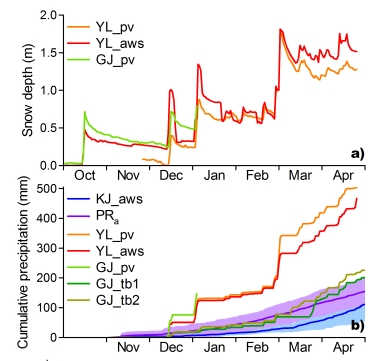The disaster that unfolded in Langtang Valley in the moments after the M7.8 Nepal Earthquake on 25 April 2017 is difficult to contemplate. The earthquake-triggered collapse of glaciers high above the serene village of Langtang Valley contributed to a devastating avalanche that swept down from the mountains with a leading edge of straight-line winds that approached major tornado strength. New research led by Koji Fujita from Nagoya University, published in the open-access journal Natural Hazards and Earth System Science (link), suggests that the avalanche may have actually been composed primarily of snow. The intersection of a rare (1 in 100 to 1 in 500 year) snowpack and a major earthquake (1 in 80 years) led to one of the biggest mass casualty events of the earthquake.

- Perspective views of Langtang Village avalanche deposit. (a) orthoimage, and (b) pre- and post-event elevation difference.
In the paper, we use a combination of data collected from helicopter and UAV surveys in the days and months after the earthquake to quadruple previous estimates of the total volume of the avalanche deposit (Figure 1 above). Koji, who has worked in the valley since the 1980s and is well known by the villagers, also interviewed locals who witnessed the blast to help constrain the sequence of events. Finally, we pieced together weather station data from the valley (ICIMOD/DHM) and regional precipitation fields to determine the return period for a winter snowpack of this magnitude.
The winter of 2014-2015 was particularly wet: the passage of Cyclone HudHud in October 2014 dropped upwards of 300 mm of precipitation in the Langtang region, and caused numerous avalanche fatalities on the famed Annapurna trekking circuit. When I visited Langtang Valley after the earthquake, most of our stations appeared to be destroyed by earthquake-triggered avalanches. However,after recovering the dataloggers and downloading the data, it became clear that some were toppled in the middle of winter by avalanches that also took out entire yak herds (according to the locals I spoke to).
The stations that remained standing during the winter told the story of near-continuous snowfall from early March to 25 April (Figure 2). If snowfall during the typhoon is included, snowpacks may have been up to 3.5 m at high elevations. This snowpack only needed a trigger to go off, and on 25 April at 11:57, it got two: one from the ground motion, and one from the glacier ice cliff collapses.

Our results have been shared with both local and government officials, but hotels have already started to appear in the rubble that lies over the avalanche.